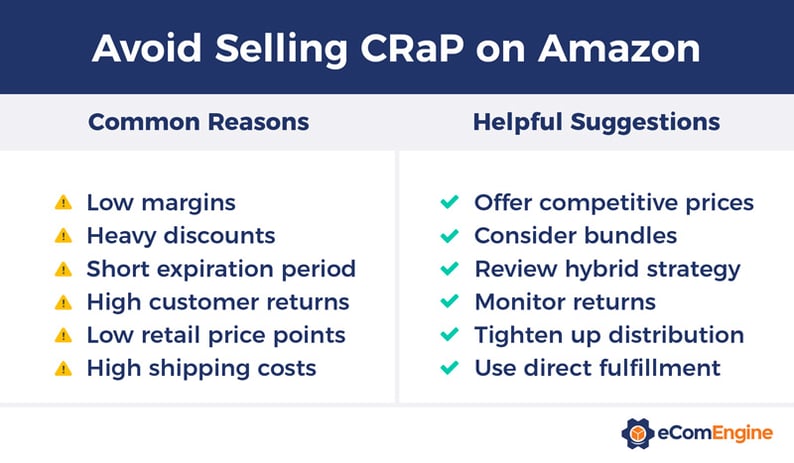Originally published on February 11, 2020, updated November 29, 2022
Menu
Join Our Email List
- Receive our monthly newsletter.
- Stay up to date on Amazon policies.
- Get tips to grow your business.
CRaP is one of the best Amazon acronyms to date. It actually stands for “Can’t Realize a Profit” and refers to products that do not make a profit. This is a term Amazon uses when reviewing the profitability of vendor products.
For many years, Amazon’s focus was on gaining market share across numerous product categories, even if this meant sacrificing their bottom line. Now that Amazon is more established with large market shares in major retail industries, the focus has naturally shifted to profitability. Amazon is focusing on profit margins. If a product can’t provide a profitable margin, Amazon doesn't want it.
Below I have listed the most common reasons an item may not realize a profit on Amazon.
If the vendor did not offer Amazon good margins or allowances from the beginning, the product may be unprofitable from day one. While vendors don’t want to give Amazon their best price, they do need to offer a good enough margin for both parties to be profitable.
If there is lots of price matching on an item and resellers are engaging in price wars to win the Buy Box, Amazon may no longer be willing to compete and sacrifice margin.
Once an expiration period comes close to an end, the products are disposed of. This happens when demand drops and inventory becomes aged and overstocked.
There are costs involved when handling returns. While Amazon often builds this into its allowances, if returns are high Amazon may end up having to fund more than agreed upon by the vendor.
Items that typically retail under the $10 mark will often be unprofitable due to the cost of shipping, even if the profit percentage is high.
Items that are heavy to ship, large, or an odd shape can be costly to ship. These can often cost more to ship than the product is worth.
Once you have identified why items are or could be unprofitable, you need a solution. Here are some suggestions to consider.

Always review your products before listing them on Amazon and make sure they have a good chance of being profitable for both your business and Amazon. While there are some scenarios you cannot plan for, there are some more obvious cases where you know the items aren’t going to be profitable from day one. Select your products wisely and avoid wasting time on items that are just not suited for the vendor platform.
Originally published on February 11, 2020, updated November 29, 2022
This post is accurate as of the date of publication. Some features and information may have changed due to product updates or Amazon policy changes.
These Stories on Amazon
14321 Winter Breeze Drive
Suite 121 Midlothian, VA 23113
Call us: 800-757-6840





Copyright© 2007-2025 eComEngine, LLC. All Rights Reserved. eComEngine®, FeedbackFive®, RestockPro®, and SellerPulse® are trademarks or registered trademarks of eComEngine, LLC. Amazon's trademark is used under license from Amazon.com, Inc. or its affiliates.
No Comments Yet
Let us know what you think